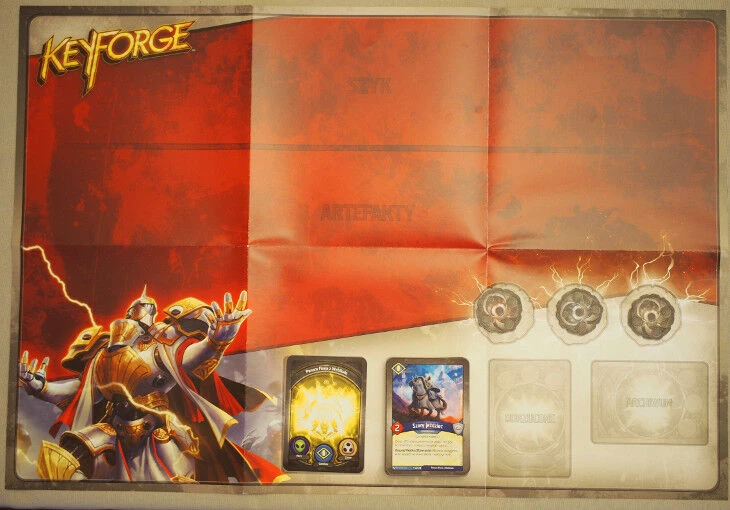KeyForge: Time of Ascension - The Starter Pack is the second starter kit for a unique card game that premiered at the end of May last year. What will you find in the box? What is its uniqueness? Isn't it some mad scientist's experiment? Is it worth being interested in? See for yourself by reading this review.
The game world
The Crucible is a mysterious artificial celestial body made up of countless planets. In this world live Archons, extremely wise, almost divine beings (who do not know the history of their origin), who clash in battle, assisted by representatives of various factions. What are they fighting for? Of course, it’s about discovering and conquering the vaults that hide the sources of power and ultimate knowledge.
Hmm… Isn’t it too epic anymore?

What is this all about?
KeyForge , as we can read on the box, is a unique game. The deck we get is unique in the world and no one has the same set of cards as we do. In addition, the name of the deck is also unique, as is its symbol on the back of each card.
The set of cards we play is randomly selected by an algorithm, the operation of which probably only knows the author and producer. To keep the game balance at least partially in check, the deck consists of three houses out of
seven (Brobnar, Logos, Sanktum, Shadows, Mars, Dis, Untamed).
Each of the three houses is represented by 12 cards. Within the aforementioned dozen, we can find four types: actions, artifacts, creatures, improvements. Their number can vary, but it is never the case that the 12 cards in question would not have any of these types.
Interestingly, the deck cannot be modified in any way. You open the box, take out the deck and play with what you have. Sounds cosmic? So, in order not to keep you in suspense any longer, let’s get to the point, which is how is it played?

The rules of the game in a nutshell
We start the game by giving each player one deck of cards, a playing mat and three keys.
On the mat, in a specially designated place, place three keys with the unforged side up (i.e. the more colorful side down). Then, from our deck, we separate an identity card, on which on one side we have a list of cards in our deck, and on the other side, a unique picture and a unique name of the deck. Place the identity card on the table in front of you on the mat in the marked place, with the name up. On this card we will collect Æmber (which I will write about in a moment).
In a place accessible to both players, place the following tokens: damage, stun, strength and, of course, Æmber. Finally, we shuffle our decks and begin the game. According to the instructions of the first player, you should draw for example by tossing a coin, but you can also select him in some less conventional way. The object of the game is to forge three keys represented by special tokens.

When the token is forged, turn it over to the forged side (more colored). To forge a key, a player must have at least 6 Æmber tokens on his identity card at the start of his turn.
The game consists of individual player turns, which are performed alternately until one of the players forges 3 keys, then the game ends immediately.
A turn consists of the following five steps:
- Forge a key
- Choosing a house
- Play, execute, and discard cards of the chosen house
- Preparation of cards
- Drawing cards
The first turn is a bit different from the rest. The first player takes 7 cards and the second player 6. In the first turn, we skip the first step, which is forging a key, because at this stage of the game none of the players is able to do it.
The second step, i.e. choosing a house, is standard. The player looks at his hand of cards and chooses from 3 houses whose names are given on the identity card. The house he has chosen is called the active house. (In the case shown in the picture below, the first player, the Grim Fiona of the Vehicle, has a choice of the following three houses: Mars, Sanctum, and Shadows; the second player, Shiny Corporal, among the houses: Untamed, Brobnar, and Shadows.
Step three: once the player has chosen a house on the first turn and ONLY the first player can choose ONE card from his hand from the house he has declared and play or discard it.
In the remaining turns (including the second player’s first turn), the player may play, use (already on the table) or discard (from hand) any number of cards belonging to the active house. In step four, the player prepares all his exhausted cards, ie the ones he used, but did not have to discard them.
Step five is to draw as many cards from the top of your deck until the player has 6 in hand. In this step, the player must also declare, if he has enough Æmber, that he will forge a key next turn. Then it is the turn of the other player. The game continues until you forge three keys.
But how to get that precious Æmber. It can be obtained in several ways: sometimes there is a Æmber symbol on the card that we play, and then we get as much of it as we have drawn on the card. Another way is the so-called “collecting” action. During your turn, instead of fighting with the played creature, you can “tire it” and gain 1 Æmber. Cards also have certain abilities that allow you to either collect extra Æmber for something or steal it from your opponent.

Why is it worth playing?
KeyForge is a mystery game from the very beginning. When it was announced that Fantasy Flight Games, in collaboration with Richard Garfield, was planning to release a card game in which each deck would be unique, everyone wondered how was it possible that some printing company could do this? This information is still lost in the darkness of the Crucible.
What can be said about the KeyForge game ? It is intriguing, it seems innovative and groundbreaking in terms of the way it is produced.
The game should especially appeal to players who have not dealt with many card games, or old veterans who would like to feel a breath of fresh air and take a break from the tedious (although very enjoyable) folding of their decks of cards and play spontaneously, without hours of preparation, analysis and strategy.
Besides, buying and opening another pack is a bit like opening a surprise egg in childhood, you never know what combination of three factions you will get, what set of cards you will get. The only difference (about surprise eggs, of course) is that you have little chance of finding a toy that will be of no use to you. You can always try out a given deck and test new card combinations as you play. You open it, watch it and play it. Only this and so much.
Another dilemma is whether to buy KeyForge: Ascension Time – Starter Pack , or two decks and replace all the necessary markers with something. The original markers are helpful and I personally prefer to play with them. In the single boxes with decks you will not find instructions (but it is available online). Which option you choose depends on you and your wallet. But in fact, your choice won’t affect the clou of the game itself, which remains the same.
Finally, it is worth considering if KeyForge is a game that will replace Magic the Gathering ? Probably nobody knows. The game is on a roll right now, especially on the foreign market. However, Magic the Gathering is already well established. Will the uncertainty, the thrill of opening the next pack of KeyForge and the delight of discovering win with thoughtful, calculated and styled decks in other card games? Is there still room on the market for such a return to the past? Time will tell. For now, however, as I have already mentioned, the title is not losing popularity and the publisher is not slowing down. Currently, the third KeyForge starter kit is also available : Collision of Worlds. In addition, the fourth KeyForge starter kit: Mass Mutation is also planned to be released in the second quarter of this year .
For my part, I recommend the game to try it out and feel the childhood joy of playing and discovering your unique deck of cards.
Weronika Radzikowska-Juś


